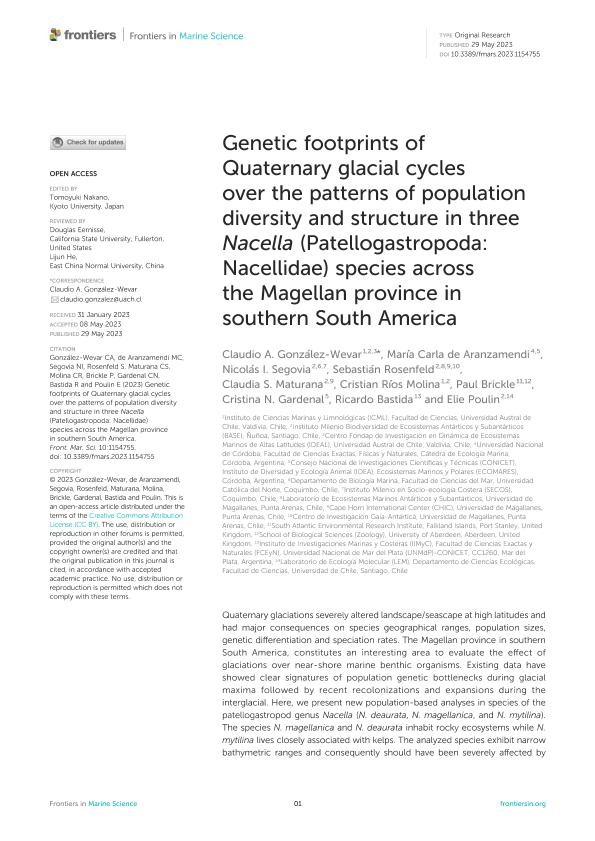Artículo
Genetic footprints of Quaternary glacial cycles over the patterns of population diversity and structure in three Nacella (Patellogastropoda: Nacellidae) species across the Magellan province in southern South America
Gonzalez Wevar, Claudio A.; de Aranzamendi, Maria Carla ; Segovia, Nicolás I.; Rosenfeld, Sebastian; Maturana, Claudia S.; Rios Molina, Cristián; Brickle, Paul; Gardenal, Cristina Noemi
; Segovia, Nicolás I.; Rosenfeld, Sebastian; Maturana, Claudia S.; Rios Molina, Cristián; Brickle, Paul; Gardenal, Cristina Noemi ; Bastida, Ricardo Oscar
; Bastida, Ricardo Oscar ; Poulin, Elie
; Poulin, Elie
 ; Segovia, Nicolás I.; Rosenfeld, Sebastian; Maturana, Claudia S.; Rios Molina, Cristián; Brickle, Paul; Gardenal, Cristina Noemi
; Segovia, Nicolás I.; Rosenfeld, Sebastian; Maturana, Claudia S.; Rios Molina, Cristián; Brickle, Paul; Gardenal, Cristina Noemi ; Bastida, Ricardo Oscar
; Bastida, Ricardo Oscar ; Poulin, Elie
; Poulin, Elie
Fecha de publicación:
05/2023
Editorial:
Frontiers Media
Revista:
Frontiers In Marine Science
ISSN:
2296-7745
Idioma:
Inglés
Tipo de recurso:
Artículo publicado
Clasificación temática:
Resumen
Quaternary glaciations severely altered landscape/seascape at high latitudes and had major consequences on species geographicalranges, population sizes, genetic differentiation, and speciation rates. The Magellan province in southern South America,constitutes an interesting area to evaluate the effect of glaciations over near-shore marine benthic organisms. Existing data haveshowed clear signatures of population genetic bottlenecks during glacial maxima followed by recent recolonizations and expansionsduring the interglacial.Here, we present new population-based analyses in species of the patellogastropod genus Nacella (N. deaurata, N. magellanica, andN. mytilina). The species N. magellanica and N. deaurata inhabit rocky ecosystems while N. mytilina lives closely associated tokelps. The analyzed species exhibit narrow bathymetric ranges and consequently should have been severely affected by recurrentglacial cycles. We performed phylogeographic and demographic analyses in Nacella species including different localities across theirrespective distributions in the Magellan province including the Falkland/Malvinas Islands (F/M).Genetic analyses showed that all Nacella species exhibited low levels of genetic diversity, the presence of single dominant broadlydistributed haplotypes, lack of correlation between geographical and genetic distance, and recent demographic growths which areevidence supporting rapid postglacial expansions. Such results may have been facilitated by larval and/or rafting-mediateddispersal following the Cape Horn Current System. The three species showed strong and significant differentiation between F/Mand southern Pacific margin (SPM) populations including localities across the Strait of Magellan and Cape Horn. Haplotypegenealogies and mismatch analyses recognized older and more complex demographic histories in the F/M than in South America.Different glaciological histories between SPM and F/M may be responsible of the marked phylogeographic structure in the analyzedspecies of Nacella. Alternatively, as previously proposed, the F/M represent a glacial refugium for Nacella species (sink area), aswell as a secondary contact zone where endemic haplotypes are found together with recently arrived South American ones.Historical and contemporary processes, contrasting glacial histories between the analyzed areas, as well as life history traits ofthe analyzed organisms are main factors explaining current phylogeographic patterns of shallow Magellan marine benthicorganisms.
Palabras clave:
PHYLOGEOGRAPHY
,
LAST GLACIAL MAXIMUM
,
NACELLA
,
QUATERNARY
,
POPULATION GENETICS
Archivos asociados
Licencia
Identificadores
Colecciones
Articulos(IDEA)
Articulos de INSTITUTO DE DIVERSIDAD Y ECOLOGIA ANIMAL
Articulos de INSTITUTO DE DIVERSIDAD Y ECOLOGIA ANIMAL
Citación
Gonzalez Wevar, Claudio A.; de Aranzamendi, Maria Carla; Segovia, Nicolás I.; Rosenfeld, Sebastian; Maturana, Claudia S.; et al.; Genetic footprints of Quaternary glacial cycles over the patterns of population diversity and structure in three Nacella (Patellogastropoda: Nacellidae) species across the Magellan province in southern South America; Frontiers Media; Frontiers In Marine Science; 10; 5-2023; 1-19
Compartir
Altmétricas



